Addressing Overtourism Challenges in Canada's Mountain Parks
VerifiedAdded on 2022/08/08
|5
|2193
|21
Case Study
AI Summary
This case study examines the issue of overtourism within Canada's Mountain National Parks, focusing on the environmental and societal impacts of excessive tourism. The paper highlights the exponential increase in visitors since the area was declared a UNESCO World Heritage Site and the resulting strain on the natural ecosystem and local communities. The study analyzes the adverse effects of overtourism, including pollution and disturbance to wildlife. It proposes sustainable tourism practices, collaboration with local communities, and awareness campaigns as potential mitigation strategies. The paper references the successful implementation of similar strategies in Barcelona and concludes with a call for proactive measures to preserve the natural beauty and heritage of Canada's Mountain National Parks, emphasizing the importance of responsible tourism and community involvement to address the challenges of overtourism and protect the environment. The paper also analyzes the case of Barcelona, which used similar sustainable tourism and local community collaboration approaches to solve the overtourism crisis. The effectiveness of the solutions is also discussed.
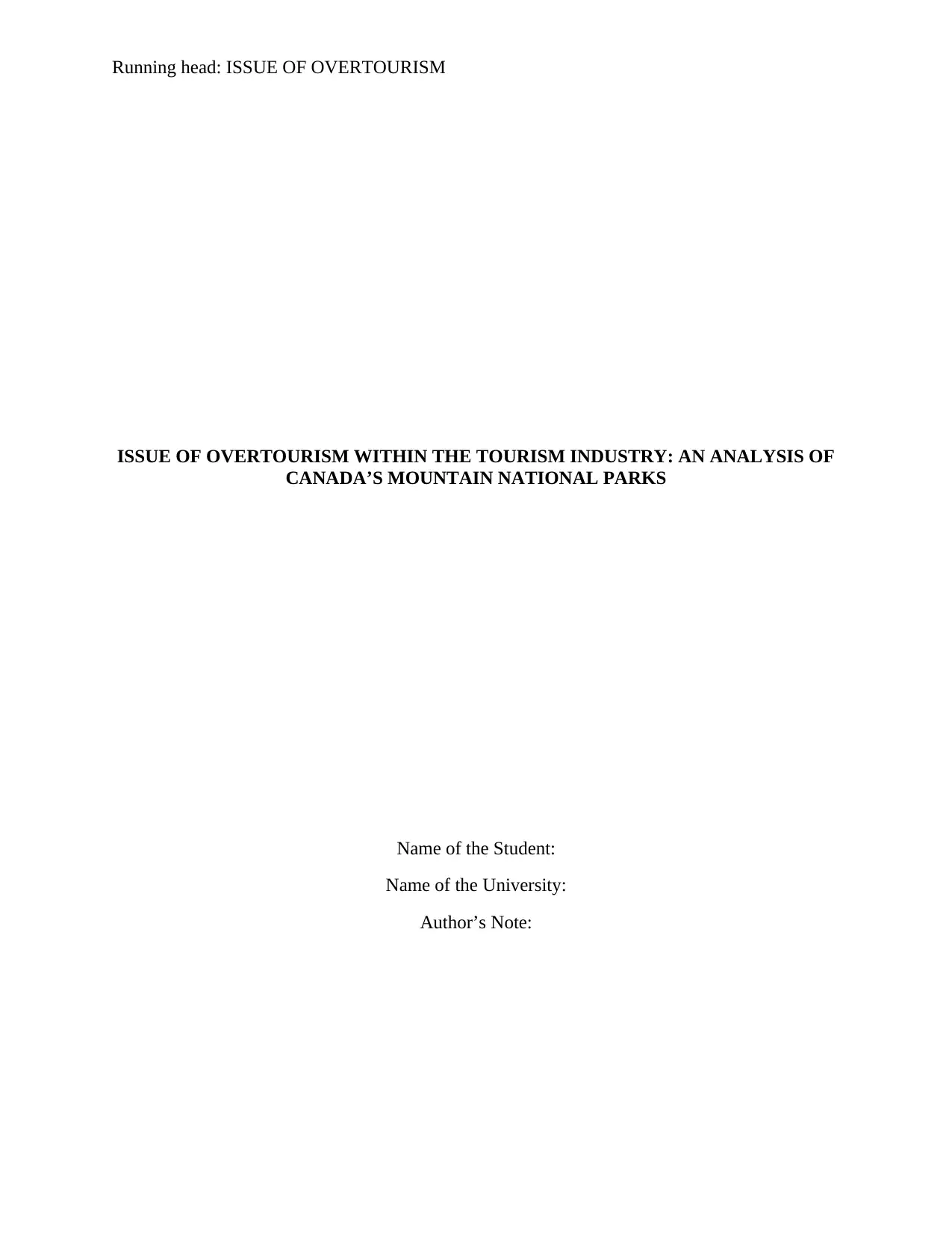
Running head: ISSUE OF OVERTOURISM
ISSUE OF OVERTOURISM WITHIN THE TOURISM INDUSTRY: AN ANALYSIS OF
CANADA’S MOUNTAIN NATIONAL PARKS
Name of the Student:
Name of the University:
Author’s Note:
ISSUE OF OVERTOURISM WITHIN THE TOURISM INDUSTRY: AN ANALYSIS OF
CANADA’S MOUNTAIN NATIONAL PARKS
Name of the Student:
Name of the University:
Author’s Note:
Paraphrase This Document
Need a fresh take? Get an instant paraphrase of this document with our AI Paraphraser
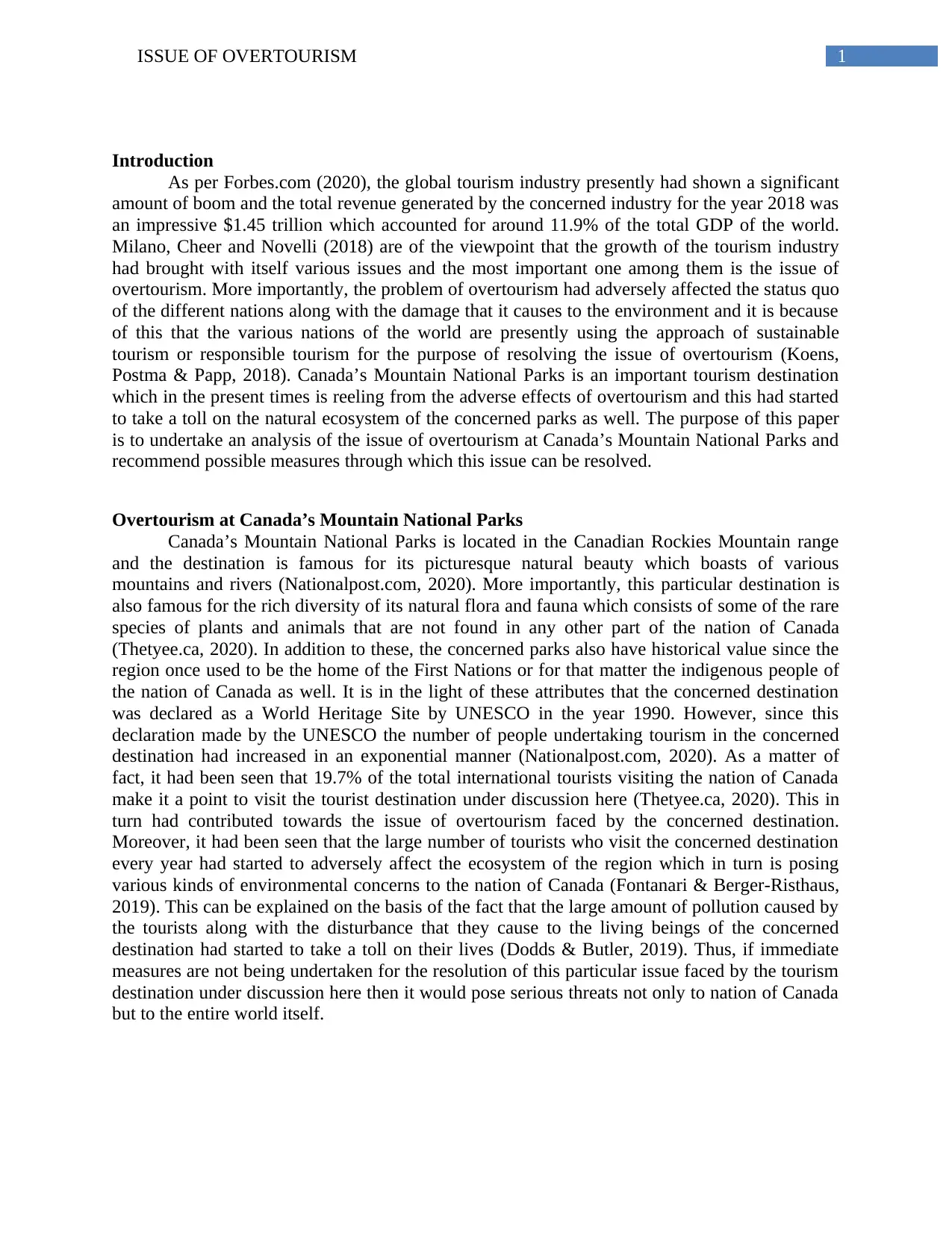
1ISSUE OF OVERTOURISM
Introduction
As per Forbes.com (2020), the global tourism industry presently had shown a significant
amount of boom and the total revenue generated by the concerned industry for the year 2018 was
an impressive $1.45 trillion which accounted for around 11.9% of the total GDP of the world.
Milano, Cheer and Novelli (2018) are of the viewpoint that the growth of the tourism industry
had brought with itself various issues and the most important one among them is the issue of
overtourism. More importantly, the problem of overtourism had adversely affected the status quo
of the different nations along with the damage that it causes to the environment and it is because
of this that the various nations of the world are presently using the approach of sustainable
tourism or responsible tourism for the purpose of resolving the issue of overtourism (Koens,
Postma & Papp, 2018). Canada’s Mountain National Parks is an important tourism destination
which in the present times is reeling from the adverse effects of overtourism and this had started
to take a toll on the natural ecosystem of the concerned parks as well. The purpose of this paper
is to undertake an analysis of the issue of overtourism at Canada’s Mountain National Parks and
recommend possible measures through which this issue can be resolved.
Overtourism at Canada’s Mountain National Parks
Canada’s Mountain National Parks is located in the Canadian Rockies Mountain range
and the destination is famous for its picturesque natural beauty which boasts of various
mountains and rivers (Nationalpost.com, 2020). More importantly, this particular destination is
also famous for the rich diversity of its natural flora and fauna which consists of some of the rare
species of plants and animals that are not found in any other part of the nation of Canada
(Thetyee.ca, 2020). In addition to these, the concerned parks also have historical value since the
region once used to be the home of the First Nations or for that matter the indigenous people of
the nation of Canada as well. It is in the light of these attributes that the concerned destination
was declared as a World Heritage Site by UNESCO in the year 1990. However, since this
declaration made by the UNESCO the number of people undertaking tourism in the concerned
destination had increased in an exponential manner (Nationalpost.com, 2020). As a matter of
fact, it had been seen that 19.7% of the total international tourists visiting the nation of Canada
make it a point to visit the tourist destination under discussion here (Thetyee.ca, 2020). This in
turn had contributed towards the issue of overtourism faced by the concerned destination.
Moreover, it had been seen that the large number of tourists who visit the concerned destination
every year had started to adversely affect the ecosystem of the region which in turn is posing
various kinds of environmental concerns to the nation of Canada (Fontanari & Berger-Risthaus,
2019). This can be explained on the basis of the fact that the large amount of pollution caused by
the tourists along with the disturbance that they cause to the living beings of the concerned
destination had started to take a toll on their lives (Dodds & Butler, 2019). Thus, if immediate
measures are not being undertaken for the resolution of this particular issue faced by the tourism
destination under discussion here then it would pose serious threats not only to nation of Canada
but to the entire world itself.
Introduction
As per Forbes.com (2020), the global tourism industry presently had shown a significant
amount of boom and the total revenue generated by the concerned industry for the year 2018 was
an impressive $1.45 trillion which accounted for around 11.9% of the total GDP of the world.
Milano, Cheer and Novelli (2018) are of the viewpoint that the growth of the tourism industry
had brought with itself various issues and the most important one among them is the issue of
overtourism. More importantly, the problem of overtourism had adversely affected the status quo
of the different nations along with the damage that it causes to the environment and it is because
of this that the various nations of the world are presently using the approach of sustainable
tourism or responsible tourism for the purpose of resolving the issue of overtourism (Koens,
Postma & Papp, 2018). Canada’s Mountain National Parks is an important tourism destination
which in the present times is reeling from the adverse effects of overtourism and this had started
to take a toll on the natural ecosystem of the concerned parks as well. The purpose of this paper
is to undertake an analysis of the issue of overtourism at Canada’s Mountain National Parks and
recommend possible measures through which this issue can be resolved.
Overtourism at Canada’s Mountain National Parks
Canada’s Mountain National Parks is located in the Canadian Rockies Mountain range
and the destination is famous for its picturesque natural beauty which boasts of various
mountains and rivers (Nationalpost.com, 2020). More importantly, this particular destination is
also famous for the rich diversity of its natural flora and fauna which consists of some of the rare
species of plants and animals that are not found in any other part of the nation of Canada
(Thetyee.ca, 2020). In addition to these, the concerned parks also have historical value since the
region once used to be the home of the First Nations or for that matter the indigenous people of
the nation of Canada as well. It is in the light of these attributes that the concerned destination
was declared as a World Heritage Site by UNESCO in the year 1990. However, since this
declaration made by the UNESCO the number of people undertaking tourism in the concerned
destination had increased in an exponential manner (Nationalpost.com, 2020). As a matter of
fact, it had been seen that 19.7% of the total international tourists visiting the nation of Canada
make it a point to visit the tourist destination under discussion here (Thetyee.ca, 2020). This in
turn had contributed towards the issue of overtourism faced by the concerned destination.
Moreover, it had been seen that the large number of tourists who visit the concerned destination
every year had started to adversely affect the ecosystem of the region which in turn is posing
various kinds of environmental concerns to the nation of Canada (Fontanari & Berger-Risthaus,
2019). This can be explained on the basis of the fact that the large amount of pollution caused by
the tourists along with the disturbance that they cause to the living beings of the concerned
destination had started to take a toll on their lives (Dodds & Butler, 2019). Thus, if immediate
measures are not being undertaken for the resolution of this particular issue faced by the tourism
destination under discussion here then it would pose serious threats not only to nation of Canada
but to the entire world itself.
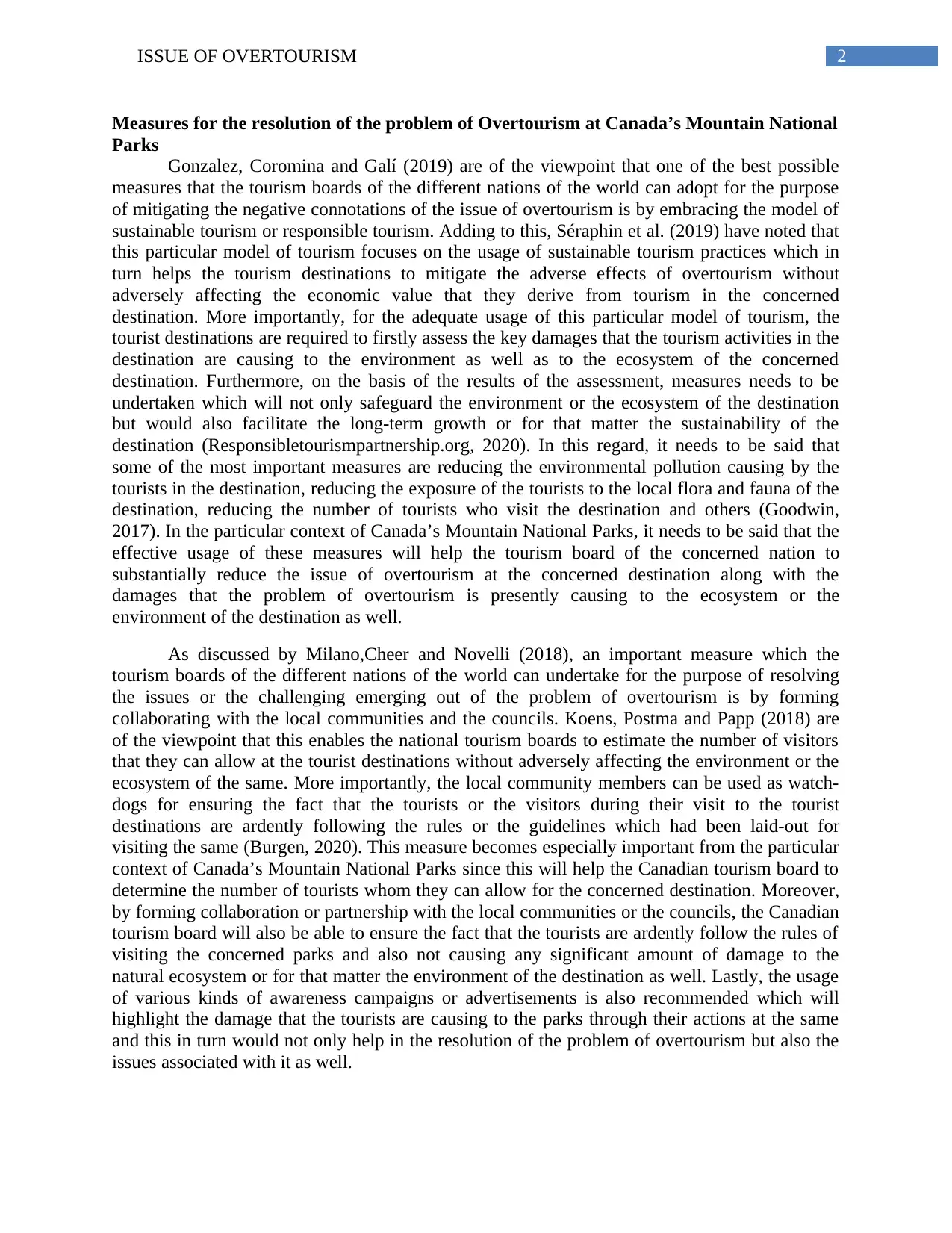
2ISSUE OF OVERTOURISM
Measures for the resolution of the problem of Overtourism at Canada’s Mountain National
Parks
Gonzalez, Coromina and Galí (2019) are of the viewpoint that one of the best possible
measures that the tourism boards of the different nations of the world can adopt for the purpose
of mitigating the negative connotations of the issue of overtourism is by embracing the model of
sustainable tourism or responsible tourism. Adding to this, Séraphin et al. (2019) have noted that
this particular model of tourism focuses on the usage of sustainable tourism practices which in
turn helps the tourism destinations to mitigate the adverse effects of overtourism without
adversely affecting the economic value that they derive from tourism in the concerned
destination. More importantly, for the adequate usage of this particular model of tourism, the
tourist destinations are required to firstly assess the key damages that the tourism activities in the
destination are causing to the environment as well as to the ecosystem of the concerned
destination. Furthermore, on the basis of the results of the assessment, measures needs to be
undertaken which will not only safeguard the environment or the ecosystem of the destination
but would also facilitate the long-term growth or for that matter the sustainability of the
destination (Responsibletourismpartnership.org, 2020). In this regard, it needs to be said that
some of the most important measures are reducing the environmental pollution causing by the
tourists in the destination, reducing the exposure of the tourists to the local flora and fauna of the
destination, reducing the number of tourists who visit the destination and others (Goodwin,
2017). In the particular context of Canada’s Mountain National Parks, it needs to be said that the
effective usage of these measures will help the tourism board of the concerned nation to
substantially reduce the issue of overtourism at the concerned destination along with the
damages that the problem of overtourism is presently causing to the ecosystem or the
environment of the destination as well.
As discussed by Milano,Cheer and Novelli (2018), an important measure which the
tourism boards of the different nations of the world can undertake for the purpose of resolving
the issues or the challenging emerging out of the problem of overtourism is by forming
collaborating with the local communities and the councils. Koens, Postma and Papp (2018) are
of the viewpoint that this enables the national tourism boards to estimate the number of visitors
that they can allow at the tourist destinations without adversely affecting the environment or the
ecosystem of the same. More importantly, the local community members can be used as watch-
dogs for ensuring the fact that the tourists or the visitors during their visit to the tourist
destinations are ardently following the rules or the guidelines which had been laid-out for
visiting the same (Burgen, 2020). This measure becomes especially important from the particular
context of Canada’s Mountain National Parks since this will help the Canadian tourism board to
determine the number of tourists whom they can allow for the concerned destination. Moreover,
by forming collaboration or partnership with the local communities or the councils, the Canadian
tourism board will also be able to ensure the fact that the tourists are ardently follow the rules of
visiting the concerned parks and also not causing any significant amount of damage to the
natural ecosystem or for that matter the environment of the destination as well. Lastly, the usage
of various kinds of awareness campaigns or advertisements is also recommended which will
highlight the damage that the tourists are causing to the parks through their actions at the same
and this in turn would not only help in the resolution of the problem of overtourism but also the
issues associated with it as well.
Measures for the resolution of the problem of Overtourism at Canada’s Mountain National
Parks
Gonzalez, Coromina and Galí (2019) are of the viewpoint that one of the best possible
measures that the tourism boards of the different nations of the world can adopt for the purpose
of mitigating the negative connotations of the issue of overtourism is by embracing the model of
sustainable tourism or responsible tourism. Adding to this, Séraphin et al. (2019) have noted that
this particular model of tourism focuses on the usage of sustainable tourism practices which in
turn helps the tourism destinations to mitigate the adverse effects of overtourism without
adversely affecting the economic value that they derive from tourism in the concerned
destination. More importantly, for the adequate usage of this particular model of tourism, the
tourist destinations are required to firstly assess the key damages that the tourism activities in the
destination are causing to the environment as well as to the ecosystem of the concerned
destination. Furthermore, on the basis of the results of the assessment, measures needs to be
undertaken which will not only safeguard the environment or the ecosystem of the destination
but would also facilitate the long-term growth or for that matter the sustainability of the
destination (Responsibletourismpartnership.org, 2020). In this regard, it needs to be said that
some of the most important measures are reducing the environmental pollution causing by the
tourists in the destination, reducing the exposure of the tourists to the local flora and fauna of the
destination, reducing the number of tourists who visit the destination and others (Goodwin,
2017). In the particular context of Canada’s Mountain National Parks, it needs to be said that the
effective usage of these measures will help the tourism board of the concerned nation to
substantially reduce the issue of overtourism at the concerned destination along with the
damages that the problem of overtourism is presently causing to the ecosystem or the
environment of the destination as well.
As discussed by Milano,Cheer and Novelli (2018), an important measure which the
tourism boards of the different nations of the world can undertake for the purpose of resolving
the issues or the challenging emerging out of the problem of overtourism is by forming
collaborating with the local communities and the councils. Koens, Postma and Papp (2018) are
of the viewpoint that this enables the national tourism boards to estimate the number of visitors
that they can allow at the tourist destinations without adversely affecting the environment or the
ecosystem of the same. More importantly, the local community members can be used as watch-
dogs for ensuring the fact that the tourists or the visitors during their visit to the tourist
destinations are ardently following the rules or the guidelines which had been laid-out for
visiting the same (Burgen, 2020). This measure becomes especially important from the particular
context of Canada’s Mountain National Parks since this will help the Canadian tourism board to
determine the number of tourists whom they can allow for the concerned destination. Moreover,
by forming collaboration or partnership with the local communities or the councils, the Canadian
tourism board will also be able to ensure the fact that the tourists are ardently follow the rules of
visiting the concerned parks and also not causing any significant amount of damage to the
natural ecosystem or for that matter the environment of the destination as well. Lastly, the usage
of various kinds of awareness campaigns or advertisements is also recommended which will
highlight the damage that the tourists are causing to the parks through their actions at the same
and this in turn would not only help in the resolution of the problem of overtourism but also the
issues associated with it as well.
⊘ This is a preview!⊘
Do you want full access?
Subscribe today to unlock all pages.

Trusted by 1+ million students worldwide
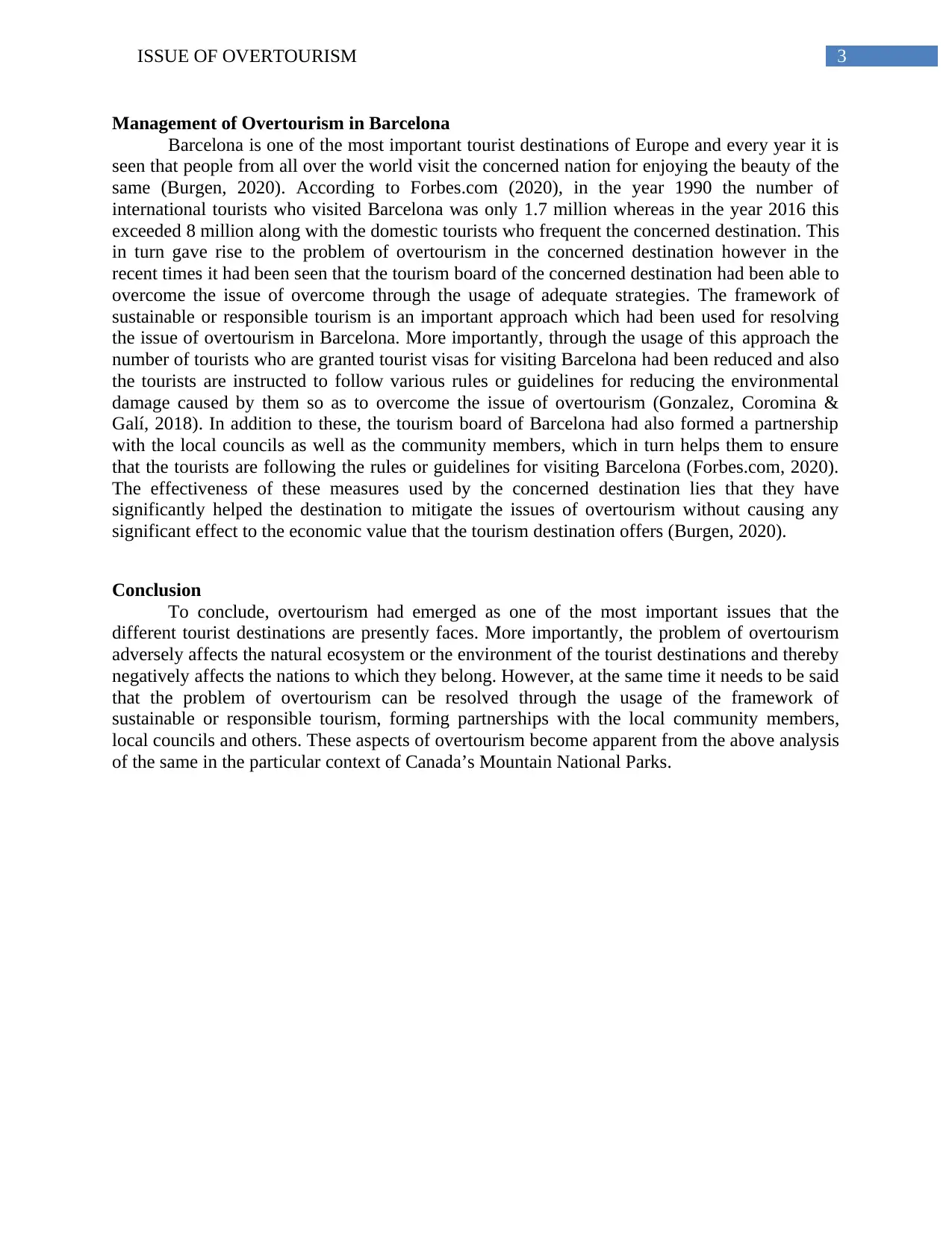
3ISSUE OF OVERTOURISM
Management of Overtourism in Barcelona
Barcelona is one of the most important tourist destinations of Europe and every year it is
seen that people from all over the world visit the concerned nation for enjoying the beauty of the
same (Burgen, 2020). According to Forbes.com (2020), in the year 1990 the number of
international tourists who visited Barcelona was only 1.7 million whereas in the year 2016 this
exceeded 8 million along with the domestic tourists who frequent the concerned destination. This
in turn gave rise to the problem of overtourism in the concerned destination however in the
recent times it had been seen that the tourism board of the concerned destination had been able to
overcome the issue of overcome through the usage of adequate strategies. The framework of
sustainable or responsible tourism is an important approach which had been used for resolving
the issue of overtourism in Barcelona. More importantly, through the usage of this approach the
number of tourists who are granted tourist visas for visiting Barcelona had been reduced and also
the tourists are instructed to follow various rules or guidelines for reducing the environmental
damage caused by them so as to overcome the issue of overtourism (Gonzalez, Coromina &
Galí, 2018). In addition to these, the tourism board of Barcelona had also formed a partnership
with the local councils as well as the community members, which in turn helps them to ensure
that the tourists are following the rules or guidelines for visiting Barcelona (Forbes.com, 2020).
The effectiveness of these measures used by the concerned destination lies that they have
significantly helped the destination to mitigate the issues of overtourism without causing any
significant effect to the economic value that the tourism destination offers (Burgen, 2020).
Conclusion
To conclude, overtourism had emerged as one of the most important issues that the
different tourist destinations are presently faces. More importantly, the problem of overtourism
adversely affects the natural ecosystem or the environment of the tourist destinations and thereby
negatively affects the nations to which they belong. However, at the same time it needs to be said
that the problem of overtourism can be resolved through the usage of the framework of
sustainable or responsible tourism, forming partnerships with the local community members,
local councils and others. These aspects of overtourism become apparent from the above analysis
of the same in the particular context of Canada’s Mountain National Parks.
Management of Overtourism in Barcelona
Barcelona is one of the most important tourist destinations of Europe and every year it is
seen that people from all over the world visit the concerned nation for enjoying the beauty of the
same (Burgen, 2020). According to Forbes.com (2020), in the year 1990 the number of
international tourists who visited Barcelona was only 1.7 million whereas in the year 2016 this
exceeded 8 million along with the domestic tourists who frequent the concerned destination. This
in turn gave rise to the problem of overtourism in the concerned destination however in the
recent times it had been seen that the tourism board of the concerned destination had been able to
overcome the issue of overcome through the usage of adequate strategies. The framework of
sustainable or responsible tourism is an important approach which had been used for resolving
the issue of overtourism in Barcelona. More importantly, through the usage of this approach the
number of tourists who are granted tourist visas for visiting Barcelona had been reduced and also
the tourists are instructed to follow various rules or guidelines for reducing the environmental
damage caused by them so as to overcome the issue of overtourism (Gonzalez, Coromina &
Galí, 2018). In addition to these, the tourism board of Barcelona had also formed a partnership
with the local councils as well as the community members, which in turn helps them to ensure
that the tourists are following the rules or guidelines for visiting Barcelona (Forbes.com, 2020).
The effectiveness of these measures used by the concerned destination lies that they have
significantly helped the destination to mitigate the issues of overtourism without causing any
significant effect to the economic value that the tourism destination offers (Burgen, 2020).
Conclusion
To conclude, overtourism had emerged as one of the most important issues that the
different tourist destinations are presently faces. More importantly, the problem of overtourism
adversely affects the natural ecosystem or the environment of the tourist destinations and thereby
negatively affects the nations to which they belong. However, at the same time it needs to be said
that the problem of overtourism can be resolved through the usage of the framework of
sustainable or responsible tourism, forming partnerships with the local community members,
local councils and others. These aspects of overtourism become apparent from the above analysis
of the same in the particular context of Canada’s Mountain National Parks.
Paraphrase This Document
Need a fresh take? Get an instant paraphrase of this document with our AI Paraphraser
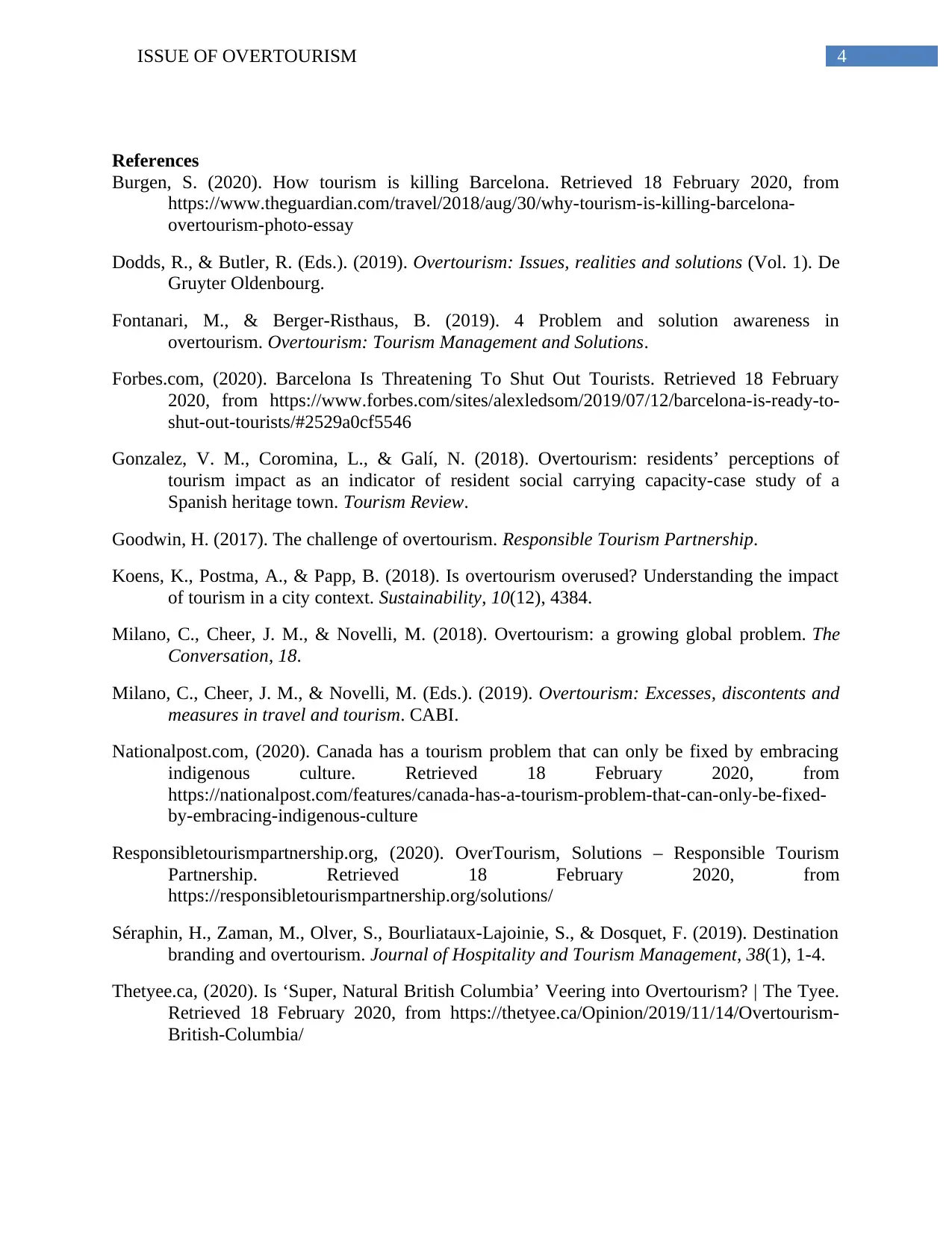
4ISSUE OF OVERTOURISM
References
Burgen, S. (2020). How tourism is killing Barcelona. Retrieved 18 February 2020, from
https://www.theguardian.com/travel/2018/aug/30/why-tourism-is-killing-barcelona-
overtourism-photo-essay
Dodds, R., & Butler, R. (Eds.). (2019). Overtourism: Issues, realities and solutions (Vol. 1). De
Gruyter Oldenbourg.
Fontanari, M., & Berger-Risthaus, B. (2019). 4 Problem and solution awareness in
overtourism. Overtourism: Tourism Management and Solutions.
Forbes.com, (2020). Barcelona Is Threatening To Shut Out Tourists. Retrieved 18 February
2020, from https://www.forbes.com/sites/alexledsom/2019/07/12/barcelona-is-ready-to-
shut-out-tourists/#2529a0cf5546
Gonzalez, V. M., Coromina, L., & Galí, N. (2018). Overtourism: residents’ perceptions of
tourism impact as an indicator of resident social carrying capacity-case study of a
Spanish heritage town. Tourism Review.
Goodwin, H. (2017). The challenge of overtourism. Responsible Tourism Partnership.
Koens, K., Postma, A., & Papp, B. (2018). Is overtourism overused? Understanding the impact
of tourism in a city context. Sustainability, 10(12), 4384.
Milano, C., Cheer, J. M., & Novelli, M. (2018). Overtourism: a growing global problem. The
Conversation, 18.
Milano, C., Cheer, J. M., & Novelli, M. (Eds.). (2019). Overtourism: Excesses, discontents and
measures in travel and tourism. CABI.
Nationalpost.com, (2020). Canada has a tourism problem that can only be fixed by embracing
indigenous culture. Retrieved 18 February 2020, from
https://nationalpost.com/features/canada-has-a-tourism-problem-that-can-only-be-fixed-
by-embracing-indigenous-culture
Responsibletourismpartnership.org, (2020). OverTourism, Solutions – Responsible Tourism
Partnership. Retrieved 18 February 2020, from
https://responsibletourismpartnership.org/solutions/
Séraphin, H., Zaman, M., Olver, S., Bourliataux-Lajoinie, S., & Dosquet, F. (2019). Destination
branding and overtourism. Journal of Hospitality and Tourism Management, 38(1), 1-4.
Thetyee.ca, (2020). Is ‘Super, Natural British Columbia’ Veering into Overtourism? | The Tyee.
Retrieved 18 February 2020, from https://thetyee.ca/Opinion/2019/11/14/Overtourism-
British-Columbia/
References
Burgen, S. (2020). How tourism is killing Barcelona. Retrieved 18 February 2020, from
https://www.theguardian.com/travel/2018/aug/30/why-tourism-is-killing-barcelona-
overtourism-photo-essay
Dodds, R., & Butler, R. (Eds.). (2019). Overtourism: Issues, realities and solutions (Vol. 1). De
Gruyter Oldenbourg.
Fontanari, M., & Berger-Risthaus, B. (2019). 4 Problem and solution awareness in
overtourism. Overtourism: Tourism Management and Solutions.
Forbes.com, (2020). Barcelona Is Threatening To Shut Out Tourists. Retrieved 18 February
2020, from https://www.forbes.com/sites/alexledsom/2019/07/12/barcelona-is-ready-to-
shut-out-tourists/#2529a0cf5546
Gonzalez, V. M., Coromina, L., & Galí, N. (2018). Overtourism: residents’ perceptions of
tourism impact as an indicator of resident social carrying capacity-case study of a
Spanish heritage town. Tourism Review.
Goodwin, H. (2017). The challenge of overtourism. Responsible Tourism Partnership.
Koens, K., Postma, A., & Papp, B. (2018). Is overtourism overused? Understanding the impact
of tourism in a city context. Sustainability, 10(12), 4384.
Milano, C., Cheer, J. M., & Novelli, M. (2018). Overtourism: a growing global problem. The
Conversation, 18.
Milano, C., Cheer, J. M., & Novelli, M. (Eds.). (2019). Overtourism: Excesses, discontents and
measures in travel and tourism. CABI.
Nationalpost.com, (2020). Canada has a tourism problem that can only be fixed by embracing
indigenous culture. Retrieved 18 February 2020, from
https://nationalpost.com/features/canada-has-a-tourism-problem-that-can-only-be-fixed-
by-embracing-indigenous-culture
Responsibletourismpartnership.org, (2020). OverTourism, Solutions – Responsible Tourism
Partnership. Retrieved 18 February 2020, from
https://responsibletourismpartnership.org/solutions/
Séraphin, H., Zaman, M., Olver, S., Bourliataux-Lajoinie, S., & Dosquet, F. (2019). Destination
branding and overtourism. Journal of Hospitality and Tourism Management, 38(1), 1-4.
Thetyee.ca, (2020). Is ‘Super, Natural British Columbia’ Veering into Overtourism? | The Tyee.
Retrieved 18 February 2020, from https://thetyee.ca/Opinion/2019/11/14/Overtourism-
British-Columbia/
1 out of 5
Related Documents
Your All-in-One AI-Powered Toolkit for Academic Success.
+13062052269
info@desklib.com
Available 24*7 on WhatsApp / Email
![[object Object]](/_next/static/media/star-bottom.7253800d.svg)
Unlock your academic potential
Copyright © 2020–2025 A2Z Services. All Rights Reserved. Developed and managed by ZUCOL.





